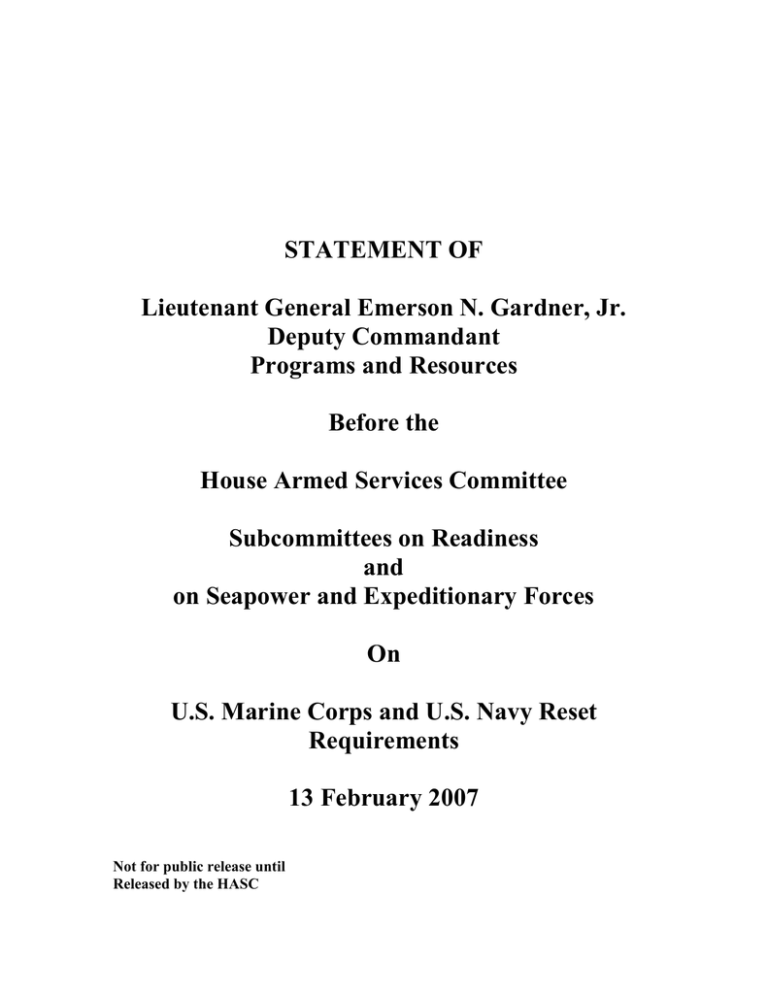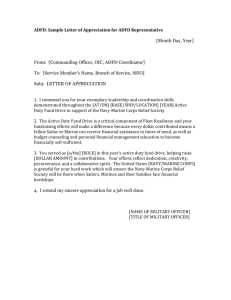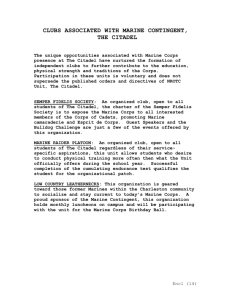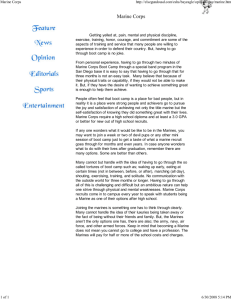STATEMENT OF Lieutenant General Emerson N. Gardner, Jr. Deputy Commandant
advertisement

STATEMENT OF Lieutenant General Emerson N. Gardner, Jr. Deputy Commandant Programs and Resources Before the House Armed Services Committee Subcommittees on Readiness and on Seapower and Expeditionary Forces On U.S. Marine Corps and U.S. Navy Reset Requirements 13 February 2007 Not for public release until Released by the HASC Introduction Chairmen Ortiz and Taylor, Ranking Members Bartlett and Davis, distinguished members of the Committee, thank you for the opportunity to report on the state of your Marine Corps. I want to specifically thank you for your steady and generous support of the Corps which has enabled your deployed Marines to succeed in their mission against a determined enemy. Your Marines recognize that this is an important time in the Corps’ long and illustrious history of service to our country. The majority of today’s Marines joined the Corps after our Nation was already at war; they joined knowing they would go into harm’s way. They joined with the understanding of what their Nation expected of them and they have shouldered this solemn duty with courage and grit. Your Marines remain committed to their mission and know that the American people and its government support them in their endeavor. It is on their behalf that I report to you today and respectfully request your support for the initiatives necessary to support the Marine Corps. Forward Readiness the Priority For over 5 years, the Marine Corps has been involved in combat and combat support operations around the globe. The nature of our missions and in particular, the current fight in Iraq, has required sustained employment of our personnel and levels of equipment density higher than any the Corps has experienced. Given our commitment to maintaining our deployed and deploying forces at the highest state of readiness possible, we have drawn the necessary personnel and equipment from across the Corps to ensure that we have correctly weighted our main effort. This prioritization of personnel and equipment for forward deployed units has caused a decline in readiness for our nondeployed units and an overall decline in the readiness of the Corps since 9/11. My intent today is to discuss how we are restoring that readiness. Endstrength Increase Our number one asset is our Marines. To restore our personnel and training levels to the standards we enjoyed before, we must ensure that we have enough to deal with our nation’s current and future challenges. The increase of the Marine Corps’ permanent endstrength to 202,000 will ensure that your Marine Corps is a balanced force with V6 1 sufficient capacity and capability to prosecute the Global War on Terrorism and serve in our statutory role as America’s force in readiness – your 9-1-1 force, most ready when the Nation is least ready. We will grow from our current temporary endstrength of 180,000 to 184,000 by the end of this fiscal year and then add 5,000 Marines per year thereafter until we attain our goal in 2011. We are initially funding this effort through a mix of baseline and supplemental appropriations but intend to have all of these costs in our baseline by FY 2009. Equipment To meet our heavy theater equipment demands, we initially drew equipment from Maritime Prepositioning Ships and prepositioned stocks in Norway, and from base units in the United States. Our efforts to “reset the force” have replenished much of the prepositioned stocks and we are beginning to see some improvement in home station readiness although we are months away from complete success. Two of our three Maritime Prepositioning Squadrons (MPSRONs) have undergone extensive equipment maintenance and have been restored to historical readiness rates of 98%. The remaining MPSRON is at about 48% and is still awaiting delivery of equipment. A bright spot in the use of our equipment is the degree to which it is remaining mission capable. As a result of the quality of our gear, great effort by a lot of people and resources provided by the Congress, the mission capable rates of equipment on hand remains well above ninety percent. While we are pleased with these high rates of readiness of the gear that we have, we are concerned that it cannot last without a long term sustainment policy. Much of the forward deployed equipment is not rotating out of theater at the conclusion of each force rotation; it remains in combat, used on a near-continuous basis at an operating tempo that far exceeds normal peacetime usage. The main reason for this lack of rotation is that there are simply not enough spares or maintenance float for certain items to provide a spare to the employed forces while the equipment is in heavy or depot maintenance. Uparmored vehicles are a good example. As a result of the lack of rotation, much of our equipment has been subjected to a lifetime’s worth of wear from high vehicle mileage, long operating hours, and harsh environmental conditions in a relatively short period of V6 2 time. The table below provides examples of increased operational tempo for representative Marine Corps equipment sets. Table 1 Absolute Increases in Utilization for Selected Marine Corps Systems Employed in OIF Usage Category HMMWV MTVR LVS AAV Rotary-Wing Aircraft KC-130 Pre OIF OIF 183 500 375 83 550 2000 1500 417 Optempo Ratio 3.0 4.0 4.0 5.0 18 43 41 83 2.2 1.9 NOTE: Usage rates for ground vehicles are expressed in miles per month. For aircraft, the rates reflect flying hours per month. These factors and the exigencies of the conflict in Iraq and the greater Global War on Terror have increased our equipment maintenance and replacement costs far beyond what is available in our baseline budget. The challenge of restoring and maintaining traditional capabilities while fielding new capabilities to ensure success in the Global War on Terror has come to be known as “resetting the force”. With your help over the last two years, we have begun to make progress in restoring our equipment readiness, but there is much work to be done if we are to win the current fight and still be able to deal with the other challenges that face our country. Reset the Force After a standardization of definitions of “reset the force” within DoD in September 2006, we estimated the cost to reset the Marine Corps to be $13.7B as of the end of FY 2006. This is a rolling estimate that includes an estimate of two years worth of depot maintenance at the conclusion of the current hostilities and is thus somewhat variable. To date the Congress has provided $10.2 billion in supplemental funding for procurement and operations and maintenance to enable the Corps to achieve this goal. The table below outlines our progress in getting procurement funding on contract to begin converting it into delivered capabilities and restored readiness. V6 3 Table 2 Reset Procurement Appropriations and Obligations (Green and Blue) ($ Billions) Procurement as of 8 February 2007 Appropriated Committed % Committed Remaining FY 06 4.6 3.7 80% 0.9 FY 07 4.2 2.3 55% 1.9 Total 8.8 6.0 68% 2.8 With your help over the last two years we have begun to make progress in restoring our equipment readiness. There will be significant costs once the conflict in Iraq is complete. Depot maintenance, the process by which we restore equipment back to optimal working condition, will take several years past the end of the conflict. Only then will the Marine Corps be completely “reset”. Challenges of Resetting the Force One of the challenges to restoring lost readiness is the lag time between the loss of a combat asset whether through enemy action or extensive use and delivering its replacement. The challenge of replacing lost equipment no longer in active production, limited production capacities, re-tooling time, and the time lags inherent in the requirements-resources-acquisition process all contribute to lag times of as much as 88 months. Table 3 depicts some examples. Table 3 Capability First Loss Funding Replacement Lag Equip Date Appropriated Equip Date Time* UH-1N Dec-01 Oct-06 UH-1Y Apr-09 88 KC-130R Jan-02 Oct-06 KC-130J Apr-10 99 Attack Helo AH-1W Jan-03 Oct-06 AH-1Z Apr-09 75 Medium Lift Helo CH-46E Mar-03 Jul-06 MV-22 Sep-09 78 Wheeled Recon LAV-25 Apr-03 May-05 LAV-25 Dec-07 56 Medium Wheeled Transport MTVR May-03 May-05 MTVR Apr-06 35 Utility Helo Transport *Lag Time in months V6 4 While the Congress has funded a significant portion of our equipment replacement requirements, some crucial equipment is still many months from delivery. In the end, it is deliveries that count when restoring readiness. Adapting to the Enemy Since the beginning of operations in Iraq, your Marine Corps has adapted its equipment to counter evolving threats. We initially deployed with un-armored HMMWVs, but quickly realized that our vehicles required protection against Improvised Explosive Devices (IEDs). We developed Marine Armored Kits (MAKs) to apply to existing HMMWVs and have now evolved to the use of M1114s, HMMWVs with factory installed armor. No Marine goes “outside the wire” in OIF in a vehicle that is not armored. The enemy has adapted and begun to use more powerful IEDs and to bury them thus taking advantage of the flat chasses of our vehicles. The solution to this problem is the use of vehicles with a V-shaped underbelly and higher ground clearance. Known as a Mine Resistant Ambush Protected (MRAP) vehicle, this provides the best protection for your Marines in harm’s way. Theater experience shows that when attacked by an IED, a Marine in an MRAP is 4 to 5 times safer than a Marine in an up-armored HMMWV. The Marine Corps needs 3,700 MRAPs to protect Marines currently exposed to the IED threat in HMMWVs. This is an updated number from our previous testimony of 1,022 vehicles that will allow our commanders to replace our armored HMMWVs in theater on a one for one basis. This policy decision is quite recent and is not reflected in the submissions provided to the Congress to date. The DoD is aggressively pursuing the acquisition of this rapidly emerging MRAP requirement. As the program manager for this family of vehicles, the Commanding General, Marine Corps Systems Command is buying all of the small production capacity currently available. In an effort to expand production capacity and introduce competition, he recently awarded contracts to nine companies to produce four MRAP test vehicles each. These prototypes will undergo testing to ensure that they meet force protection and performance standards which will lead to production contract awards as soon as possible. It is our intent purchase contract logistics support to further accelerate fielding. V6 5 The MRAP is expensive. The three categories of MRAP vehicles and associated government furnished radios and jammers will cost at least $900,000 each. The total cost for a buy of 3700 vehicles will exceed $3.7 billion. The Congress appropriated approximately $600 million toward this cost in the FY 2007 Title IX appropriation. The MRAP is an example of our adaptation to evolving threats. It is an attempt to acquire the very best technology available in the very shortest amount of time in order to protect our Marines. The vehicles are incredibly heavy; they do not lend themselves to use aboard amphibious ships, and they are extremely expensive. MRAP is a theater specific solution and not intended to be part of our long term tactical vehicle mobility portfolio. Working with the Army, we are developing a long term solution known as the Joint Lightweight Tactical Vehicle (JLTV). The JLTV will leverage the latest technology in force protection, mobility, and fuel efficiency. The development of the JLTV speaks to the overall concept of reset – taking advantage lessons learned by using new technologies to enable our warfighters to succeed in future conflicts. We are robustly funding the research and development effort for the JLTV in order to accelerate its fielding. We are doubtful, however, that this vehicle can be developed and fielded in quantities for at least five years. Our immediate force protection and future mission needs thus mandate the two track approach, procuring MRAP while pursuing JLTV. Conclusion Due to the outstanding support of the Congress, the Marine Corps has achieved success in getting the funding needed to meet our reset requirements. We are working to improve our readiness for non-deployed units – through increasing the number of Marines and acquiring equipment that is currently being used in Iraq and Afghanistan. Challenges still remain, but we are confident that our plan to reset the Marine Corps will be realized in the near future. I thank you for the opportunity to report to you on this important matter. V6 6




